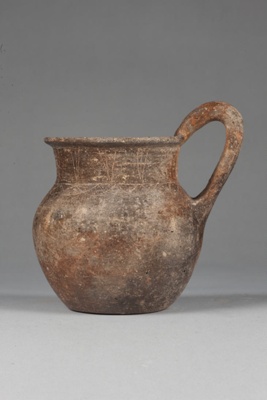< Collection search
< Collection highlights
From:UC Teece Museum of Classical Antiquities
Name/TitleJug
About this objectImpasto is a rough, impure clay known for its inclusions of mica and stone chips. First used by the Villanovan culture in central Italy, it became the popular material for use by their successors, the Etruscans. Impasto was used to make simple, functional everyday wares such as cooking pots, cups, bowls, and storage vessels like this jug.
This vase has been fired a dark grey-brown. The surface is polished, and the mica and stone chips are visible in the surface. The high-arching handle is similar in shape to a kyathos (dipper cup). The combination of high handle and flattened base meant this jug could be used as a ladle or server as well as storage or table jug.
The upper zone of the vase is decorated with fine incision. On the neck is a zone of pendant rays run between horizontal lines. From the lower line, a string of overlapping loops runs around the shoulder. Very similar vessels have been found in Pitigliano (in southern Tuscany), some with identical decoration. The design appears to be influenced by the neighbouring Faliscan style, with aspects borrowed from Etrusco-Corinthian painted pottery.
Date Madeca. 650-550 BCE
PeriodVillanovan
Place MadeItaly
Medium and MaterialsCeramic: Pottery; Impasto
Style and IconographyEtruscan
Style and IconographyArchaic
TechniqueMolding (forming)
TechniqueIncising
TechniqueGlazing (coating process)
MeasurementsHeight (at lip) 108mm; Height (including handle) 130mm; Diameter 103mm
Subject and Association KeywordsRepetition (aesthetics)
Named CollectionThe James Logie Memorial Collection, University of Canterbury, New Zealand
Credit LineDonated by Mrs Broadhead, 1968. From the collection of Professor H.D. Broadhead.
Object number85.68
Copyright LicenceAll rights reserved
